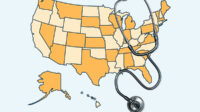If you’re an osteopathic physician attempting to navigate the continuing medical education requirements, you have our sympathy. At the highest level, the AOA Category 1-A CME requirements are put in place to sharpen your skills and provide the best patient care, however, navigating the space to find out exactly how many hours you need can be confusing. This CME guide from the American Osteopathic Association is a great resource to hone in on your AOA CME requirements, and how you can best satisfy them.
The AOA encourages DO physicians to earn 120 credits over the course of three years. Thirty of these CME credits should be Category 1-A, and the remaining 90 can be 1-A, 1-B, 2-A or 2-B.
For those specialties and subspecialties that have fewer than 300 certificate holders (full list below), those AOA Category 1-A credits can often be hard to find. That’s why the AOA allows those members to apply up to 15 CME credits per cycle from AMA PRA Category 1 Credits™ and/or AAFP Category 1 Credits to their AOA 1-A credit requirement.
While it may sound confusing it’s actually quite a benefit for these DOs. This means that half of your Category 1-A credits can come from any service that offers AMA PRA Category 1 Credits™ and/or AAFP Category 1 Credits, which are typically much easier to find.
These are the three stipulations to take advantage of this:
- You must be a member of AOA
- You must be AOA or ABMS certified
- It must be an AOA qualifying specialty or subspecialty.
Before committing to purchasing any CME activities, you should contact your certifying board to be sure you are eligible. Simply go to your board with a list of potential CME activities that you would like to apply to your CME requirements to inform them of your intent before moving forward in a purchase.
Here’s the full list of AOA Qualifying Specialties/Subspecialties as of March 2016:
- Addiction Medicine
- Adolescent & Young Adult Medicine
- Adolescent Medicine
- Adult and Pediatric Allergy and Immunology
- Allergy and Immunology
- Anatomic Pathology
- Anatomic Pathology & Laboratory Medicine
- Anesthesiology-Pain Management
- Angiography & Interventional Radiology
- Body Imaging
- Cardiothoracic Surgery
- Child Neurology
- Child Psychiatry
- Clinical Cardiac Electrophysiology
- Correctional Medicine
- Critical Care-Anesthesiology
- Critical Care-Medicine
- Critical Care-Surgery
- Dermatopathology
- Diagnostic Ultrasound
- Emergency Medical Services
- Endocrinology
- Female Pelvic Medicine/Reconstructive Surgery
- Forensic Pathology
- Gastroenterology
- General Vascular Surgery
- Geriatric Psychiatry
- Geriatrics-Internal Medicine
- Gynecologic Oncology
- Hand Surgery
- Hematology
- Infectious Diseases
- Interventional Cardiology
- Laboratory Medicine
- Primary Maternal & Fetal Medicine
- Medical Toxicology
- MOHS Micrographic Surgery
- Neonatology
- Nephrology
- Neurological Surgery
- Neurology
- Neurophysiology
- Neuroradiology
- Nuclear Medicine
- Nuclear Radiology
- Occupational Medicine
- Oncology
- Otolaryngic Allergy
- Pain Medicine
- Pediatric Allergy & Immunology
- Pediatric Dermatology
- Pediatric Endocrinology
- Pediatric Pulmonology
- Pediatric Radiology
- Physical Medicine & Rehabilitation
- Plastic & Reconstructive Surgery
- Preventive Medicine-Aerospace Medicine
- Preventive Medicine-Occupational Medicine
- Preventive Medicine-Public Health
- Preventive-Occupational-Environmental Medicine
- Proctology
- Pulmonary Diseases
- Radiation Oncology
- Radiation Therapy
- Reproductive Endocrinology
- Rheumatology
- Sleep Medicine
- Sports Medicine
- Thoracic Cardiovascular Surgery
- Thoracic Surgery
- Undersea and Hyperbaric Medicine
- Urological Surgery
- Vascular/Interventional Radiology
Where can you find these AOA Category 1-A credits?
BoardVitals offers AMA PRA Category 1 Credits™ in their online CME question banks in a wide variety of specialties and thus qualifies for many of these DOs for the AOA Category 1-A conversion. Many of these activities have also been approved by the respective allopathic specialty boards for maintenance of certification credit, so approval from your osteopathic board is likely.
These question banks offer board-style cases and questions and are available online so you can answer questions on your own time. You earn credits as you go by answering the questions 70% correctly and each case comes with a detailed explanation written by top specialists and evidence-based rationale with references. You can remediate as you go while gaining a more comprehensive understanding of the topics.




